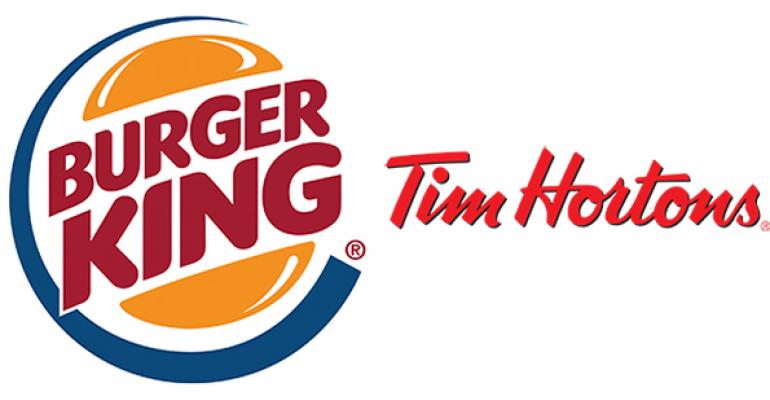Same-store sales increased 6.7 percent at Burger King in the second quarter in the chain’s best quarterly performance in nearly a decade, parent company Restaurant Brands International said on Monday.
Those results include 7.9 percent same-store sales growth in the U.S. and Canada, best for the brand in nine years, RBI CEO Daniel Schwartz said on the company’s earnings call Monday.
He said that the sales strength comes from a four-pillar plan involving improvements in the company’s menu, marketing, operations and reimaging. “We’re seeing strength across multiple dayparts,” Schwartz said. “We really attribute this to our four-pillars plan, and driving consistent execution on that plan.”
Sales in the second quarter ended June 30 were strong at both concepts owned by Oakville, Ontario-based Restaurant Brands International. Tim Hortons global same-store sales rose 5.5 percent in the second quarter, including 5.4 percent in its home Canadian market and 7 percent in the U.S.
Total revenues in the quarter fell 9 percent to $1.04 billion from $1.06 billion in the same period a year ago — before 3G Capital, the owner of RBI, engineered a merger of the two chains, Tim Hortons and Burger King, in December 2014.
Net income fell nearly 70 percent to $9.6 million, or 5 cents per share, from $31.3 million or 15 cents a year ago. On an adjusted basis, profits rose 27 percent to $143 million from $112 million.
Burger King’s sales continue to build on the chain’s momentum. Same-store sales have risen for nine quarters as the company has taken some market share in the U.S. It has also expanded aggressively in international markets. Burger King has 14,528 restaurants worldwide after adding 141 locations in the period, all but 11 in international markets.
The chain has used a menu strategy of “fewer, more impactful products,” Schwartz said, which has helped improve sales even while avoiding operational complexity that has been dogging the company’s primary competitor, McDonald’s Corp.
For instance, the company’s A1 Hearty Mozzarella Bacon Cheeseburger has “only one new item added to the kitchens,” Schwartz said.
The lack of operational complexity is helping operators make products faster. “To the extent that we’ve improved on a number of products — simple, high-selling, profitable products — that translates to better speed,” Schwartz said.
But he added that the company could improve that speed and is working toward that end. “There is an opportunity to improve speed and give customers a better drive-thru experience,” Schwartz said. “There will be a whole lot to come for many years on that front.”
By focusing on those simple items, and increasing sales in the process, Burger King has made things more profitable for operators. Though executives wouldn’t provide specifics on how profitable franchisees have been, they did say that those profits are at historic levels.
“This has been the strongest cash flow quarter in many, many years,” Schwartz said. “Franchisees are making stronger returns, they have better cash flow than ever before.”
That, he said, has an impact on the brand as a whole. The company has been reimaging more restaurants — 40 percent of the brand’s U.S. locations have been reimaged, the company said. Reimaged stores generate higher sales.
“The more profitability restaurants can generate, the more they can reinvest, the more they can reimage,” Schwartz said. “That continues our positive momentum, of delivering a great guest experience.”
The return of "The King"
The marketing recently included a return of Burger King’s “The King” at places like the Kentucky Derby and the Mayweather-Pacquiao fight, and lately in some television ads. Those appearances generated 1 billion media impressions, Schwartz said.
But he added that the return of The King doesn’t mean Burger King is going to return to its male-centric advertising message.
“If you go back in time, our marketing message had narrowed a bit, despite the fact that our guest base is everyone,” Schwartz said. “We’ve broadened our message so it’s much more inclusive and reflects who our guest base is. There’s no silver bullet to driving sales growth.
“As far as The King goes, you saw The King make a few appearances this quarter. We’re pleased with the amount of attention he was able to attract from the world, so stay tuned.”
As for Tim Hortons, the brand continued to increase sales both in the U.S. and in its home market of Canada. The company has 4,776 locations after adding 52 locations, mostly in Canada.
The chain didn’t add any locations in the U.S. — which RBI calls a “must-win market.”
But Schwartz preached patience, noting that unit economics are improving and the company and is working operators to develop new units.
“Five years ago, Burger King was only growing a couple hundred units a year,” Schwartz said. “It took us a year to learn the business, set up the right master franchise joint venture partners, and then we started to see the benefit of unit growth. Expect us to take time on the Tim Hortons business both in the U.S. and internationally as we meet with prospective partners.
“It’ll take some time. It doesn’t happen overnight.”
Contact Jonathan Maze at [email protected].
Follow him on Twitter at @jonathanmaze





